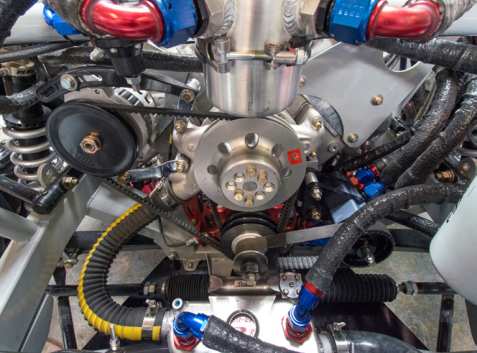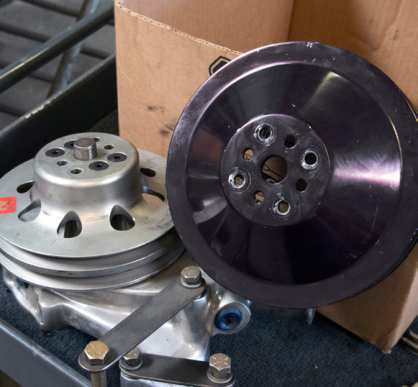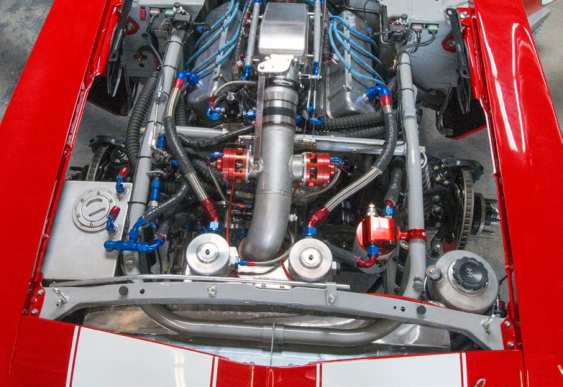METHANOL SPRAY

Big Red champions the idea of “there’s always room for improvement.” Westech Performance Group’s Eric Rhee made the suggestion to install a water-methanol injection kit from Snow Performance in order to reduce the intake air temperature (IAT). It also allows for more boost and ignition timing. The reduced IAT is a plus for Big Red’s supercharged Elephant engine because it doesn’t run an intercooler. The crew had been getting away without the intercooler because it had been running C85, which runs cooler than other similar racing fuels. Big Red uses a 70/30 water/ methanol mixture with great results.
The IAT drops about 30° when the system is engaged. The water-methanol kit also increases the octane points. On the street, a kit can turn a 91-octane fuel into 116-octane race-gas-quality fuel. The kit comes with a reservoir for the water-methanol mixture, but the shop had a nice Peterson Fluid Systems dry-sump tank lying around that would make a perfect reservoir tank. The existing brackets solidly mount the tank to the frame and factory radiator core support. Dave designed a bracket and milled it out of a quarter-inch aluminum plate, which holds the water-
methanol pump and secondary circuit solenoid. The bracket assembly is held onto the tank with two additional band clamps that wraparound the tank body. Dave welded two bungs to the intake tube upstream from the blow-off valves. The one on the driver’s side of the tube is the primary and the one on the passenger side is the secondary injector, for when more boost is needed.
Instead of using the Snow Performance control unit, the system is completely controlled by the Holley Dominator EFI ECU. It’s set up to turn on as the PRM goes up to a set amount, while a safeguard is set to shut off if the boost drops too low. Dave had to fabricate a new mounting bracket assembly for mounting the fans to the new radiator. The radiator was a tad short, so a set of aluminum blocks were attached to the top hold-down bar. That allowed the team to install the radiator in the same location and use the old brackets so the radiator assembly can be serviced easily. Racing inspectors are supposed to make sure all cars are equipped with a coolant overflow tank. The crew picked up this generic overflow tank and mounted it out of the way in front of the factory radiator core support. A hose will be attached to the radiator cap bleed port and routed to the overflow tank. Between 2004 and 2008, there was an additional hose from the coolant tank that went to a hose that stuck out of the cowl panel. If the overflow canister filled up (during a boil-over), the water squirted out of the cowl on the passenger side of the windshield.


The car had a little bit of a heating problem, so the guys installed a C&R Racing heat exchanger between the engine and the radiator. The exchanger has two separate (engine oil and engine coolant) sealed systems that flow through a single cooler to transfer heat from one fluid to the other. This balanced the temperatures of the oil and the cooling systems. Dave swapped the large-diameter water pump pulley for a smaller-diameter CV Products silver pulley from another engine so the water pump would turn faster and cool more.
Mark added Red Line Oil’s WaterWetter ® to further help reduce the somewhat high operating temperature. A stock 1969 Camaro radiator cap is rated for 16 psi. Mark installed a 21-25-psi radiator cap. It helps reduce the boiling point by increasing the pressure inside the engine. The pressure in the cooling system raises the coolant’s boiling point (about 2-3° for every pound of pressure in the system), so a proper radiator cap is a necessity. A lot of pressure builds up in a racing engine; that’s why racing radiator caps come with higher pressure ratings.